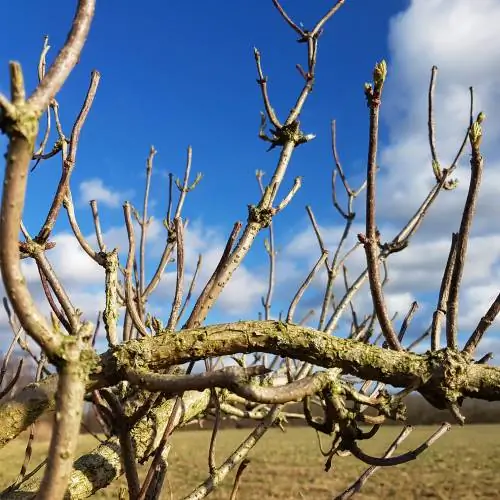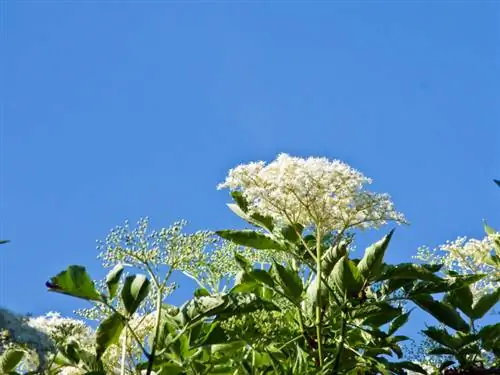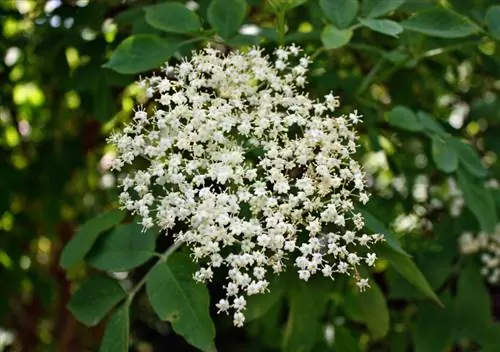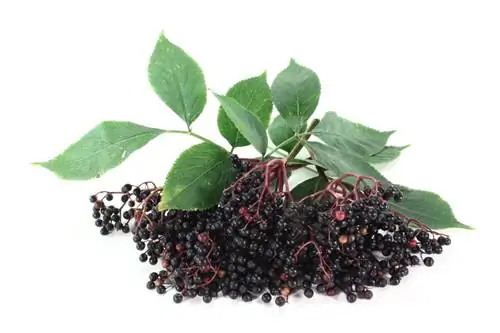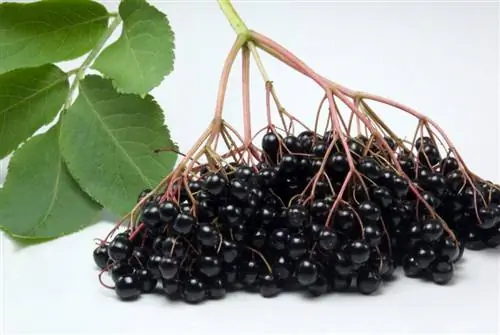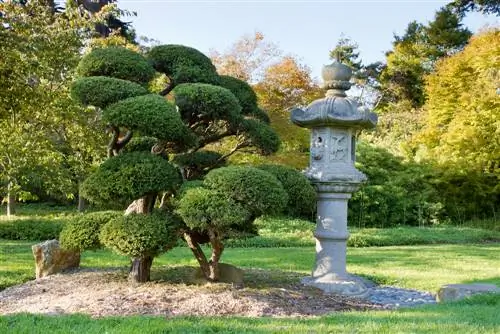- Author admin [email protected].
- Public 2023-12-24 06:09.
- Last modified 2025-06-01 06:02.
There are a variety of legends and myths surrounding the elderberry bush. Expert pruning care for a lilac berry is not very mysterious. This tutorial explains in practice how to cut black elderberry (Sambucus nigra) as a majestic solitaire, wildly romantic hedge or space-saving standard tree.
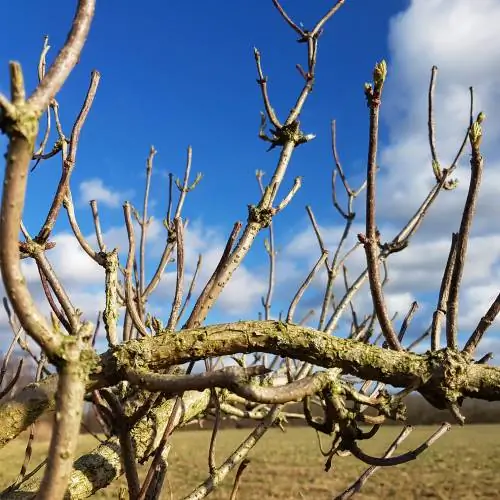
How and when should you cut the elderberry?
Cut the elderberry in autumn. Carry out the pruning after the harvest in October. The elderberry bush can also be pruned from the end of January to March. The built-up cut gives the elderberry a shape. You choose 3-6 strong ground shoots and cut off all other shoots close to the ground.
Why is a cut recommended? - Cutting options
In the wild, the sprawling elderberry bushes are a familiar sight to us, but they are rarely a feast for the eyes. Where the wild fruit tree is allowed to develop freely, it becomes as tall as a house, falls apart with bent shoots and grows old into an impenetrable shrub. With this silhouette, a Sambucus nigra is not a welcome guest in any garden. Thanks to its good-natured tolerance to pruning, you can easily keep the flower and berry bush in shape. The following overview summarizes recommended cutting options:
| Cut style | Target | Period/Occasion |
|---|---|---|
| Build-up cut | Scaffolding and orderly growth right from the start | 2. and (if necessary) 3rd year |
| Blending cut | Promotion of flower abundance and fruit yield, maintenance of shape, prevention of aging | from the 3rd or 4th year once a year |
| Rejuvenation cut | revitalize and rebuild old bush | when aging occurs |
| Educational Cut | Train young bush into a tree | Planting year up to the 3rd or 4th year |
| hedge cutting | Construction and maintenance as a free-growing, compact hedge | from the 2nd year onwards at least once a year |
| Put on the stick | rejuvenate aging, impenetrable hedges | between October 1st and March 1st |
Please note that this is a list of options for an elderberry cut. This means there is no need for rejuvenation pruning if the shrub is treated to thinning pruning every year. Pruning to form a large shrub is primarily recommended if it is clear at the time of planting that the available space at the location is limited. You should only put an old hedge on the stick if there is no way for scissors and saws to get through.
When is the best time?
An elderberry blooms and bears fruit most beautifully on its long shoots from last year. This growth behavior leaves little scope for choosing the best time to cut. Pruning after the flowering period has a detrimental effect on the fruit yield. If, on the other hand, you choose a date immediately after the autumn harvest, the worst case scenario is that the flower buds that have already formed will fall victim to the scissors, which are hardly visible at this time of year.
The best time for almost every type of cut on the elderberry is in late winter and early spring. Choose a date between late January and early March on a frost-free day. Shortly before budding, the flower buds are very swollen and easy to see. This visual aspect makes it easier for beginners to distinguish between one-year-old young shoots and worn, two-year-old and older branches.
Secondary pruning directs growth towards large shrubs
An elderberry naturally develops into a large, expansive shrub with numerous, lushly branched ground shoots, up to 10 meters high and 4 meters wide. If you cannot give the wild fruit tree so much space in the garden, direct the growth into the desired shape in the second and third year with abuilding cut. How to do it right:
- In the spring of the second year, select the3 to 6 strongest ground shoots as a framework
- Cut off all remaining shoots at ground level
- Exceptionally shorten scaffolding shoots that are too long by up to a third
If you are satisfied with the structure formation at the beginning of the third year, the construction cut leads to the thinning cut. If the shape of the shrub does not yet meet your expectations, correct the number of ground shoots in late winter. You no longer shorten annual long shoots, but slim down the shoot tips. To do this, simply cut away side shoots that are too long or growing in the wrong direction and do not fit the desired shrub shape. In this phase of pruning care, these can be both one-year and two-year-old shoots.
Pruning promotes shape and fruit quality
The annual thinning cut has the task of keeping the elder bush in shape and ensuring a rich display of flowers and berries. The focus is on preserving the annual long shoots on which numerous buds have survived the winter. This is how the uncomplicated maintenance cut works:
- Cut off bare, old scaffold shoots close to the ground to make room for young shoots
- Overhanging, worn branches indicate an annual side branch
- Completely remove two-year-old branches without fresh branches
Annual side shootsthat bloom and fruit this year characterize an upward andunbranched growth Two-year-old shoots have flowers and in the previous year Bears fruit, which can be seen in an arched, drooping state. Fresh shoots from the previous year often sprout vigorously in the lower branch area. By diverting the older wood to the young shoots, you can enjoy flowers and fruit again at this point. You can read here how to easily make the derivation cut. The following video demonstrates the simple cutting process on a young, still clear elderberry.

Elderberry rejuvenation in an exemplary manner - instructions for rejuvenation cutting
Did you inherit an old elderberry or skip pruning for several years? Then simply turn the pruning care wheel to the beginning. This can be achieved with an uncomplicatedrejuvenation cut, which you should ideally carry out in at leasttwo stages on very old and very large specimens. How to properly rejuvenate an elderberry:
- First stage: cut half of all scaffolding shoots at ground level
- Second stage: cutting the second half of the scaffold shoots
- In addition, select 3 to 5 of the best specimens from the previous year's ground shoots for the new framework
- Remove the remaining annual ground shoots as part of the second stage
The image below illustrates the professional procedure. After the rejuvenation cut, proceed to the thinning cut as explained.

Without regular thinning, an elderberry bush will age. The revitalization is achieved through the rigorous removal of the old scaffold shoots.
Raising elderberries to be standard - this is how it works
In a small garden you don't have to miss out on the natural charm of an elderberry. Thanks to its good-natured tolerance to pruning, you can train the wild fruit tree to become a space-saving standard tree. Purchase a young plant from your trusted tree nursery or use a young elderberry from the garden. Select the strongest shoot as the future trunk and place a hardwood stick at its side as a support. The support rod should reach up to the future height of the crown and be connected to the trunk. This is how you train a young elderberry bush to become a standard tree:
- Cut the tip of the central shoot above 4 to 5 sleeping eyes
- The crown shoots sprouted from the sleeping eyes
- Cut off all shoots below the crown
- Ideally tear off shoots that compete with the trunk and do not cut them off
Let the crown shoots grow uncut in the first year. Only in the spring of the second year do you cut the 4 to 5 long shoots back to 2 or 4 eyes. From the third year onwards, cut back worn-out two-year-old branches every spring or direct them to a one-year-old side shoot. To prevent the crown from becoming too sprawling and heavy, you should not leave more than 10 to 15 annual branches that bloom and bear fruit in the summer. Please stay consistently on the heels of any potential ground shoots. Because they compete with the trunk in the fight for water and nutrients, ground shoots have to give way every winter.
Cut the elderberry hedge perfectly - instructions for cutting the hedge
An elderberry hedge should not be missing in the natural garden. The wild fruit tree is an ecological jewel because it is a paradise and retreat for numerous beneficial insects. So that the hedge retains its natural character, it is trimmed more conservatively than a solitaire. The annual thinning cut also serves to create the correct shape so that the elder bushes grow densely from the base. How to proceed professionally:
- In spring, thin out the oldest ground shoots for the purpose of continuous rejuvenation
- Cut back or remove arched, overhanging, worn branches
- Do not shorten or minimally shorten young long shoots from the previous year as new flowering and fruiting wood
Give your elderberry hedge a trapezoid shape with a wide base and a narrower crown. The base of the tree must not be shaded so that it does not become bare and the hedge character is lost. Regular thinning and the promotion of loose growth in the upper area allow the light to penetrate into the interior of the bush so that photosynthesis does not come to a standstill.

Light out the 3 to 4 oldest ground shoots per hedge bush at intervals of 2 years. As a replacement, select an appropriate number of the strongest, young ground shoots. Everyone else has to move too.
Putting the elderberry hedge on the stick is limited by time
If the gardener neglects to prune an elderberry hedge for many years, the bushes turn into an unsightly tangle of shoots. Subject the entire hedge to a radical rejuvenation cut, as described in this tutorial for a solitary elderberry. It is important to note that you can only put a hedge on the tree between October 1st and March 1st. If this legal requirement is not observed, the Federal Nature Conservation Act provides for severe fines of up to 50,000 euros.
Don’t cut just anywhere - cutting technique guide
The correct pruning of elderberry is a combination of expert shoot selection and targeted pruning technique. The focus is on buds and sleeping eyes from which the lilac berries are freshly sprouting. Position the scissors or saw so that a point of vegetation is not injured. A long stub should also not be left because it can become a source of infection for diseases and pests.
When thinning a branch inside the bush or removing a crown shoot, keep an eye on the branch ring. The small bulge at the end of the branch must not be injured because it contains valuable cell tissue for subsequent wound healing. A branch ring is usually not yet visible on the young elderberry bush. In this case, make sure that the bark is not injured when making the cut.
Wound closure is outdated
If you follow the recommendation of this tutorial and cut your elderberry in late winter or early spring, you can safely put the topic of wound closure aside. Even for larger cuts, treatment is limited to smoothing the edges of the wound with a sharp knife. Please do not apply tree wax because wound closure agents prevent the valuable cambium from forming wound wood (callus).
The right tool for the perfect cut - tips about saws and scissors
Conventional secateurs quickly reach their limits on a fully grown elderberry. In return, the two-handed pruning shears with ratchet gear are oversized for training pruning. The following overview tells you the right cutting tool for every type of cut on the elderberry:
- One-handed secateurs for shoots up to 1.5 cm in diameter
- One-handed pruning shears with power amplification through ratchet gear for branches up to 3 cm in diameter
- Two-handed pruning shears with telescopic extension for branches up to 4 cm in diameter and up to 250-300 cm high
- Fixed or adjustable tree saw for all branches with a diameter of more than 4 cm
- Manual hedge trimmer with pull handle and up to 4 m range
Specialist retailers offer most scissor models with either a bypass or anvil mechanism. Each version has its advantages and disadvantages for a successful elderberry cut. The bypass scissors work with two sharp blades, but require more effort. The anvil pruner works with a sharp blade that presses the branch onto a blunt anvil. This reduces the strain on the arm, but can lead to bruising on the branch.
Electrically operated hedge trimmers are not suitable for properly cutting elderberries. As you can read in the tutorial, when it comes to shaping and thinning, a distinction is made between annual and perennial shoots. Only manual scissor models allow this selection. When purchasing, please pay attention to a long reach so that you can easily clear out dead wood deep inside the hedge.
Careful blade cleaning is a gardener's top priority
Contaminated cutting tools are the most common cause of diseases on elderberry bushes. Please clean the scissors and saw thoroughly with hot water before and after use. The blades should also be disinfected with alcohol to remove stubborn pathogens.
Important facts for the cut in brief - cut profile
A black elderberry lives up to 100 years. Over the years, proper pruning care will become second nature to you. On the way there, the central facts will help if you ever have doubts about the further cutting process in the middle of the work. The following profile summarizes all cutting-relevant properties:
- Native, summer-green wild fruit trees
- Common name: lilac berry
- Growth height: 300 to 1000 cm (varieties: 200 to 300 cm)
- Growth width: 200 to 400 cm (varieties: 120 to 200 cm)
- Annual growth: 50 to 70 cm (varieties: 10 to 40 cm)
- Flowering period: June to July
- Bud formation: last year on long shoots
- Fruit ripening: from mid-August
- Winter hardiness: very good
- Best cutting time: between the end of January and the beginning of March
- Compatibility with pruning: excellent, sprouts even from old wood
- Toxicity: slightly toxic (berries not suitable for fresh consumption)
Frequently asked questions
Is elderberry cuttings suitable for cuttings?
The annual thinning is aimed at removing the previous year's worn shoots as well as the senile, old branches. Top floral performance can no longer be expected from these branches. This year's and annual shoot tips that have not yet borne flowers or fruit are primarily suitable for propagation with cuttings.
Is elderberry poisonous?
All types of elderberry contain the toxic glycoside sambunigrin and other toxins in their leaves, shoots and berries. Consumption in large quantities can cause symptoms of poisoning in children and sensitive adults, such as cramps, nausea and vomiting. Elderberry is not recommended for the family garden with small children. The berries of the black elderberry are only suitable for consumption if they have been heated to more than 80 degrees during preparation. In various red-fruited Sambucus species, the poison content in the seeds remains, even after the berries have been cooked. It is only safe to consume once the pulp has been strained.
Keeping elderberry in a bucket - is that possible?
With a growth height of up to 5 meters, the purely wild species Sambucus nigra is not recommended for keeping in containers. The desire for an elderberry for the balcony and terrace is fulfilled by smaller varieties, such as the columnar elderberry 'Black Tower', which is limited to a maximum height of 250 centimeters and boasts black-red leaves. At 200 centimeters, the fern-leaved golden elder 'Sutherland Gold' also remains in the container-suitable range and impresses with deep yellow pinnate leaves and bright red berries. For a young plant, the pot should have at least 10 liters of volume so that the elderberry beauties can develop magnificently.
The 3 most common mistakes when cutting elderberries
| Error | Episode | Correction/Prevention |
|---|---|---|
| never photographed | The bush or crown ages, blooms and produces less and less fruit | cut out worn, two-year-old long shoots and dead wood once a year |
| cut after flowering | little or no berry covering | Cutting elderberry in late winter |
| Hedge not cut into a trapezoid shape | continuous aging and baldness from below | Forming an elderberry hedge with a wide base and a narrower crown |
Tip
Black elderberry is the progenitor of magnificent varieties that delight with larger flowers and berries. The premium variety is 'Haschberg', with berry clusters weighing up to 1,000 grams. 'Black Beauty' scores with pink flowers and dark red feathery leaves. In the small garden, 'Black Lace' boasts white flowers and deep red foliage. Among the black elder's counterparts, the grape elder Sambucus racemosa 'Plumosa Aurea' is causing a sensation with its golden yellow leaves.

